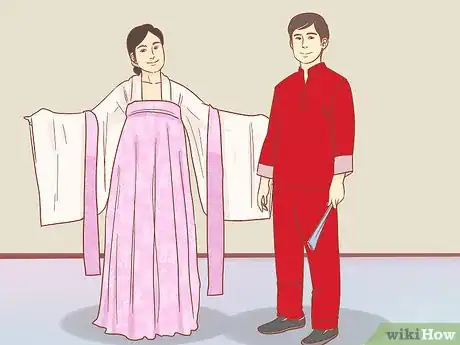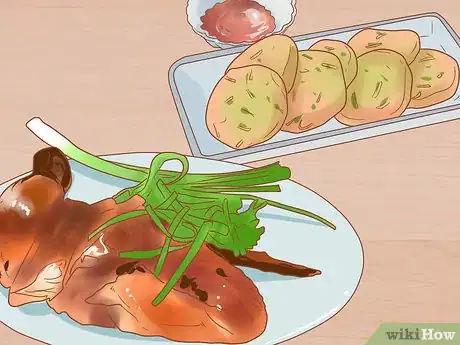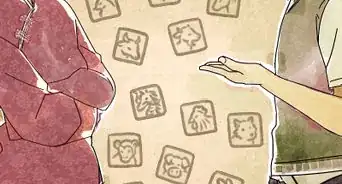wikiHow is a “wiki,” similar to Wikipedia, which means that many of our articles are co-written by multiple authors. To create this article, 85 people, some anonymous, worked to edit and improve it over time.
There are 7 references cited in this article, which can be found at the bottom of the page.
wikiHow marks an article as reader-approved once it receives enough positive feedback. In this case, 92% of readers who voted found the article helpful, earning it our reader-approved status.
This article has been viewed 610,463 times.
Learn more...
Chinese New Year, also called Lunar New Year or the Chinese Spring Festival, holds the most significant position among all Chinese festivals and holidays. It lasts for the first fifteen days of the Chinese lunar calendar, which on the Western calendar begins sometime between January 21 and February 21, varying from year to year. The celebration includes decorations, parades, folk traditions, and a wonderful feast. If you want to participate in the celebrations, there are many things you can do to join the festivities and to pay homage to Chinese traditions.
Steps
Preparing for the Holiday
-
1Clean your home. This tradition is founded in the belief that cleaning the house at this time of year will "sweep away the bad luck" that has accumulated inside over the past year.[1] Cleaning also makes the house ready for the good luck to start entering again.
- Keeping fresh and hygienic is also an important part of celebrating; even a new haircut will do.
- Don't clean your home after the New Year has started. To do so is to "sweep away" the good luck you've just received. Over the following fifteen days, or at least the first few if you can't wait that long, you are relieved of cleaning duties.
-
2Put up red decorations. Red is the color or symbol of good luck in Chinese culture and is often used for new year decorations. The number "8" also symbolizes good luck and wealth, since the Chinese character for eight rhymes with fortune or wealth.
- Paste paper cutouts onto the window. These elaborate cutouts usually depict scenes from rural life or Chinese mythology, and are traditionally put up on south and north facing windows.[2]
- Display Chinese New Year paintings and artwork. Traditionally, these contain images of health and bounty, including animals and fruit. You could include a "door god" image on your door, traditionally to fight off evil spirits and bless your house.[3]
- Hang up couplets as decoration. You can write spring-themed couplets yourself or buy Chinese calligraphy printed on red paper.
- Decorate with paper lanterns. These are made of red paper and are one of the most common decorations during Chinese New Year.
- Paint your door, doorframe, or window panes red for a real change of pace!
Advertisement -
3Arrange additional decorations. Complement the crafts and artwork with bowls of food, flowers, and other treats.
- Place flowers through the house, such as lotuses. Lotus flowers symbolize rebirth and new growth.
- Place mandarin oranges in bowls throughout the house. Mandarins with their leaves still intact are the fruits of happiness for the New Year. Use an even number and eat in pairs for good luck.[4]
- Set out a tray of eight candies. Eight is a lucky number. You can use any treats for your tray, or traditional Chinese candies made from lotus seeds, longan, peanuts, coconut, red melon seed, or candied melon.
-
4Appease the Kitchen God. Seven days before the New Year, the Kitchen God is said to report to the Jade Emperor about the household. Keep on your best behavior and offer him a sacrifice of fruit, candy, water, or other food. Some people burn a picture of the Kitchen God to send him up to heaven as smoke.
- In some areas, people traditionally prepare bean curd or tofu two days after honoring the kitchen god and eat the unpleasant residue to demonstrate thrift when the Jade Emperor comes to check up on the Kitchen God's report. You can substitute this tradition with tastier portions of tofu if you like!
Celebrating Chinese New Year
-
1Dress for the occasion. If you have traditional Chinese clothing, this is the perfect time to wear it. Outfits can be purchased in Chinatown, including beautiful silk clothing. Associated with joy, happiness, good luck, wealth and good fortune, red clothes will ensure that you're fully participating in the spirit of the celebrations. Gold is another suitable color; try combining the two colors for a festive look.
- Avoid wearing too much black during the celebration period. Black symbolizes bad luck and even death. This is a time of good fortune and life!
-
2Visit a Chinese temple. Chinese celebrators head to temples to pray for good luck during the New Year celebration period. There they burn incense sticks and have their fortunes told. Most temples welcome participants not of Chinese descent.
- You can find the tube of fortune sticks near the entrance to the temple. Ask a question and shake the tube until a numbered stick falls out. One of the fortune tellers can interpret it for you.[5]
-
3Set off firecrackers. Set off fireworks at midnight when the New Year begins. The firecrackers used in China and Hong Kong are loud, banging fireworks that are mostly lit on the ground. The loud noises are thought to scare the bad spirits away, to prevent them from bringing bad luck.[6]
- Many people continue to set off fireworks for the entire fifteen days, or at least the first four to eight days before they have to return to work. Expect a lot of noise and excitement if you're living in a Chinese community!
- Personal fireworks are banned in some countries and regions, but you may be able to watch an official fireworks display.
-
4Give gifts of money in red envelopes. Adults give lucky envelopes of money to children during this holiday. Sometimes they are given to employees or friends as well.
-
5Honor your ancestors. Show gratitude and respect for what your ancestors have done for you. There are many traditional customs associated with this if you choose to follow them, such as bowing to a shrine dedicated to them or offering them food and drink as a sacrifice.
-
6Interact with others in a positive manner. Chinese New Year is a time of happiness and good fortune and it's important to spread the goodwill. Avoid having any quarrels, fights, or negative attitudes during the New Year. These will bring you bad luck.
- Visit your family and friends often to share the New Year with them. Discuss what happened in the previous year, your plans for the coming one, and just overall enjoy your time together.
- Greet other celebrants with "Gong Xi," pronounced "gōng zee" or "gohng shee". This means "Congratulations!" Longer greetings include Gong Hei Fat Choi or Gong Xi Fa Chai in Cantonese and Mandarin Chinese respectively.
Eating Traditional Food
-
1Learn about Chinese cooking and food traditions. The main feast is usually held on New Year's Eve, before the holiday officially begins at midnight. There are countless traditional dishes, but some foods have special symbolism:
- Jiu, a traditional hard liquor, and daikon, the Chinese radish, symbolize longevity.
- Red chilies mean good luck.
- Rice ensures harmony.
- Fish, chicken, or other small animals are often served whole and cut at the table. This reminds us of our unity and prosperity.
-
2Make nian gao (sticky rice cake) for the Lantern Festival. These are filled with a variety of sweet fillings and eaten during the fifteenth day of Chinese New Year.
- Any type of dumpling can play a special role during Chinese New Year because of their shape, which resembles ancient Chinese gold or silver ingots.
-
3Cook your own feast. If you'd like to do more than simply order at the local Chinese restaurant, try these delicious recipes suitable for Chinese New Year:
- Cook Chinese dumplings. Use generous portions of cabbage or radish to celebrate prosperity. If you like, you can hide a coin or other object in one of the dumplings for someone lucky to find.[7]
- Make your own spring rolls. Spring rolls are named after the Spring Festival, so this is an excellent time to eat them![8]
- Serve plenty of fish. Fish are a sign of prosperity. Serve the fish whole and make enough to have leftovers -- it's good luck!
- Fry your own pot stickers. Pot stickers are a type of dumpling, and any dumpling is welcome at a Chinese New Year feast.
- Serve Chinese noodles in peanut sauce. Long, uncut noodles are another symbol of longevity and can be served with any sauce.
- Cook shrimp with Chinese lobster sauce. This is one example of a Chinese entrée, but there are many recipes you could use, ranging from traditional Chinese cooking to Chinese American inventions.
- Create decorated "tea eggs". These have no special connection with New Year, but are a unique Chinese treat that serves as decoration and appetizer at the same time.
Watching a Parade
-
1Find a parade in your area. Look online or in your local newspaper for information about a Chinese New Year Parade. These are sometimes held on a nearby weekend instead of New Year's Day itself, or even slightly outside the New Year period altogether.
- Remember your camera, and dress warmly if you live in an area that has to celebrate the Spring Festival in the wintertime!
- You're in luck if you live near San Francisco: its annual Chinese New Year parade is said to be the largest and oldest outside of Asia.
-
2Watch a parade on television or online. In the United States, large parades are often broadcast on local or regional television. Inside China, the national China Central Television broadcaster (CCTV) attracts hundreds of millions of viewers with their annual midnight Spring Festival Gala.
-
3Keep an eye out for the special dances. Besides firecrackers, food, activities, and music, Chinese New Year parades are a rare opportunity to watch costumed dragon dancers and lion dancers.
- The dragon dancers skillfully synchronize their dancing in one line, holding poles supporting a long, vibrant dragon. Dragons are common in Chinese mythology, in which they are revered symbols of the nation and people.[9]
- Two lion dancers share a single costume depicting a large, stylized lion. The lion is a powerful, majestic character in Chinese mythology, but the dance often includes comic elements, such as a silly monk who helps the lion track down a lettuce.[10]
- Both dances are accompanied by traditional Chinese drumming.
-
4Celebrate the Lantern Festival. On the final, fifteenth day of Chinese New Year, revelers celebrate among a multitude of decorative paper lanterns. Some cities create huge art pieces from lanterns.[11]
- Many people write riddles onto the lantern for children to solve.
- Now is the time to eat traditional sweet dumplings filled with all kinds of ingredients. These are called tangyuan.
- Put candles up on this day to guide good spirits home.
Community Q&A
-
QuestionWhy is peach blossom lucky and four an unlucky number?
 Community AnswerPeach blossom was used centuries ago by single women looking for a husband. The beauty of the plant is a reason for why it's considered lucky and women wore the blossom in their hair, as well as growing the plant in their garden, to attract men. The number “four” sounds similar to the word for “death”. This same thing holds true for many forms of spoken Chinese, Sino-Japanese and Sino-Korean. All these Asian cultures share significant historical and cultural ties, particularly with the Chinese language. Hence, this is the reason why numbers and objects which have names that are homophones for words “death” and “suffering” are typically considered unlucky in these cultures.
Community AnswerPeach blossom was used centuries ago by single women looking for a husband. The beauty of the plant is a reason for why it's considered lucky and women wore the blossom in their hair, as well as growing the plant in their garden, to attract men. The number “four” sounds similar to the word for “death”. This same thing holds true for many forms of spoken Chinese, Sino-Japanese and Sino-Korean. All these Asian cultures share significant historical and cultural ties, particularly with the Chinese language. Hence, this is the reason why numbers and objects which have names that are homophones for words “death” and “suffering” are typically considered unlucky in these cultures. -
QuestionWhat happens if you illegally set off firecrackers in your backyard? I'm a Canadian.
 Community AnswerFirecrackers are not authorized under the Explosives Act, thus making importation, possession, transportation, storage, or manufacturing illegal in Canada. If someone spots you (the sound of firecrackers is impossible to miss), they may report you to the authorities and you'll be slapped with a lawsuit by the cops. If you're charged, you will be fined of up to $7,500.00 and/or imprisonment for up to 18 months. Fines imposed for the offense would be recoverable in the same way as fines imposed as penalties for other crimes.
Community AnswerFirecrackers are not authorized under the Explosives Act, thus making importation, possession, transportation, storage, or manufacturing illegal in Canada. If someone spots you (the sound of firecrackers is impossible to miss), they may report you to the authorities and you'll be slapped with a lawsuit by the cops. If you're charged, you will be fined of up to $7,500.00 and/or imprisonment for up to 18 months. Fines imposed for the offense would be recoverable in the same way as fines imposed as penalties for other crimes. -
QuestionHow can I greet someone in Chinese New Year?
 Community AnswerRed envelopes are given to children and unmarried adults. Married couples also give red envelopes to their parents, the envelopes contain money. The money must be in new bills, and the total amount must be an even number. Certain numbers (such as four) are bad luck, so the total amount should not be one of these unlucky numbers. “Four” is a homonym for “death”, so a red envelope should never contain $4, $40, or $400.
Community AnswerRed envelopes are given to children and unmarried adults. Married couples also give red envelopes to their parents, the envelopes contain money. The money must be in new bills, and the total amount must be an even number. Certain numbers (such as four) are bad luck, so the total amount should not be one of these unlucky numbers. “Four” is a homonym for “death”, so a red envelope should never contain $4, $40, or $400.
Warnings
- If setting off firecrackers is illegal in your country, don't risk trouble with authorities or others. Countries such as Malaysia, Singapore, Thailand, Australia, New Zealand, Kenya and the United States have laws that partially, or completely ban the use of firecrackers.⧼thumbs_response⧽
References
- ↑ Barnabas and Anabel Kindersley, Nos fêtes préférées dans le monde entier (Our favorite celebrations worldwide), p. 8, (1997), ISBN 2-07-051310-6
- ↑ http://www.chinahighlights.com/travelguide/festivals/chinese-new-year-celebration.htm
- ↑ http://www.chinahighlights.com/travelguide/festivals/chinese-new-year-celebration.htm
- ↑ Barnabas and Anabel Kindersley, Nos fêtes préférées dans le monde entier (Our favorite celebrations worldwide), p. 8, (1997), ISBN 2-07-051310-6
- ↑ Jeremy Cressman, Celebrate Chinese New Year, Hong Kong style, http://www.gadling.com/2010/03/15/celebrating-chinese-new-year-hong-kong-style/
- ↑ Barnabas and Anabel Kindersley, Nos fêtes préférées dans le monde entier (Our favorite celebrations worldwide), p. 8, (1997), ISBN 2-07-051310-6
- ↑ http://www.chinahighlights.com/travelguide/chinese-food/chinese-new-year-food.htm
- ↑ http://www.chinahighlights.com/travelguide/chinese-food/chinese-new-year-food.htm
- ↑ http://gundkwok.org/what-is-dragon-dance/
About This Article
If you want to celebrate Chinese New Year with traditional foods, start with a feast on New Year’s Eve. It should include symbolic foods like jiu, a hard liquor, daikon radish for longevity, red chiles for good luck, rice for harmony, and fish or chicken to remind us of our unity and prosperity. You can also serve nian gao, which is a sweetened sticky rice cake that is served on the 15th day of Chinese New Year. Keep reading to learn the housekeeping and social traditions associated with the holiday!





















-Step-20.webp)




-Step-9.webp)















































